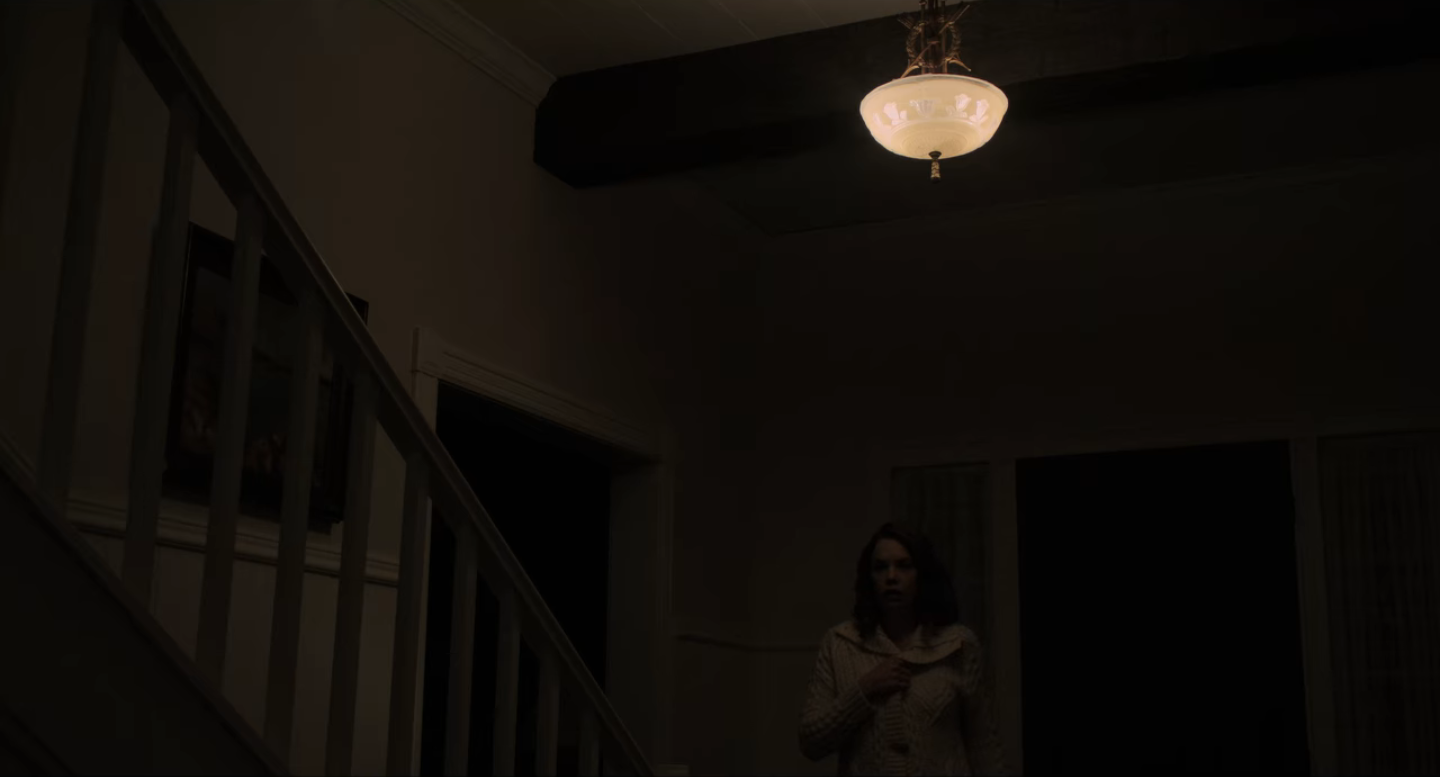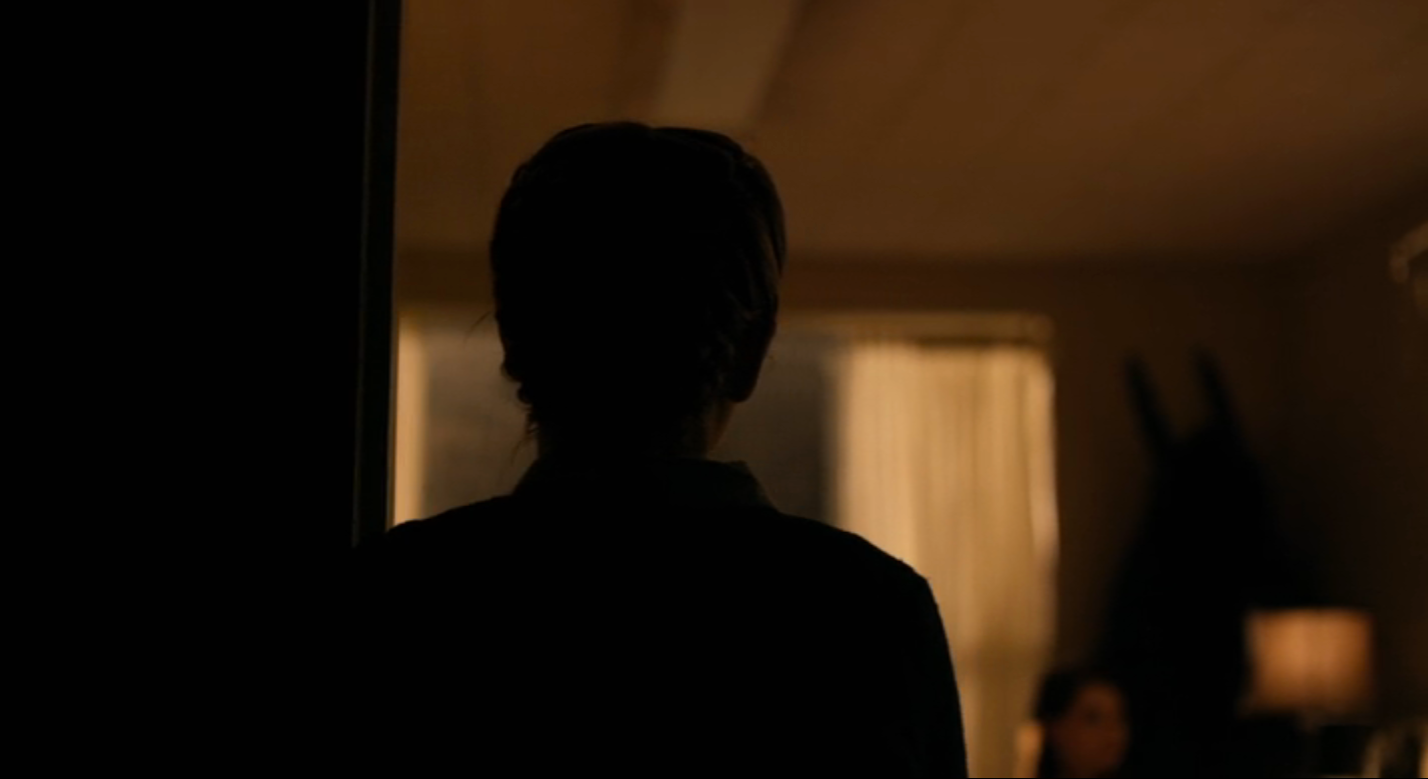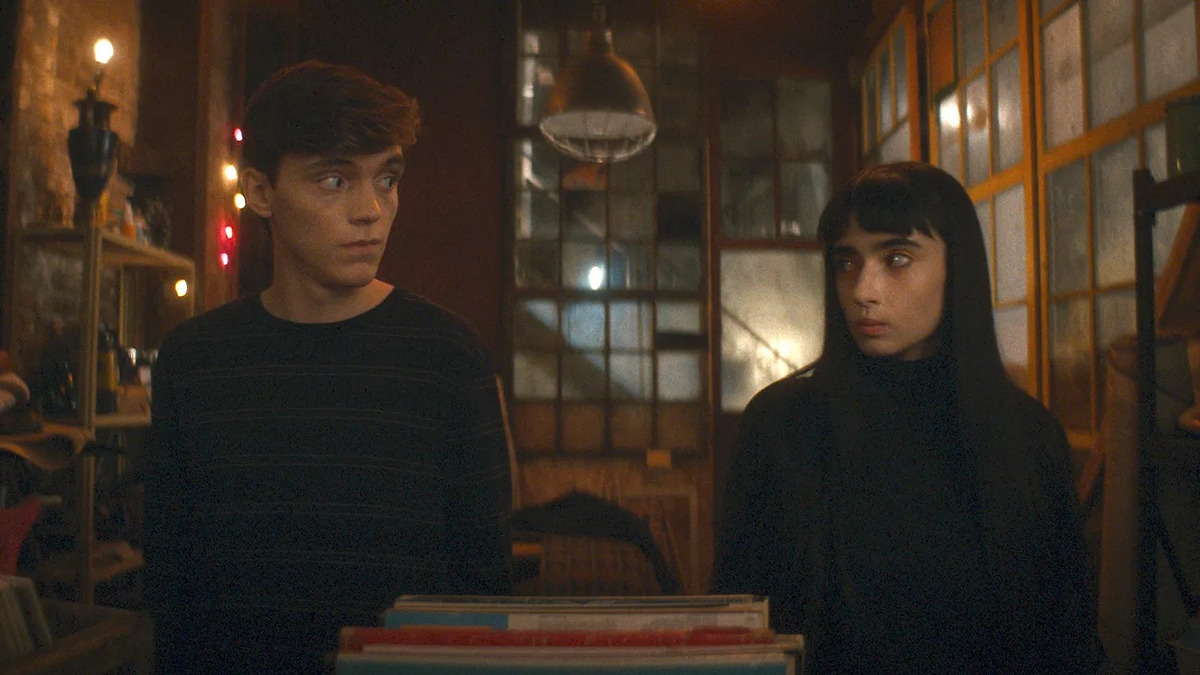The Horror of Osgood Perkins | The Blackcoat's Daughter & I Am the Pretty Thing That Lives in the House
In my last newsletter, the MaXXXine trailer had me looking back at Ti West's preceding film. In this edition, once again, a trailer—this time a damn terrifying one—has sent me on a reexploration of a filmmaker’s work. If you’re looking forward to Longlegs, prepare yourself by joining me below as I contend with the cinema of Osgood Perkins.
Spoilers ahead for the The Blackcoat's Daughter and I Am the Pretty Thing That Lives in the House.
Osgood Perkins made a name as a writer-director of horror movies in the mid-2010s with two features premiering at two successive editions of the Toronto International Film Festival — The Blackcoat's Daughter in 2015 and I Am the Pretty Thing That Lives in the House the following year. Though both prestigey, handsomely staged horror features, they are a surprising one-two punch from a filmmaker coming onto the scene: one an intricate puzzle of a possession story, the other a minimalist ghost story uninterested in twists and turns. Perkins practices, in rapid succession, two distinct approaches to story—approaches that, at first blush, appear to point in different creative directions.
Blackcoat's Daughter stands out for its careful, clever, unusual handling of story information. The film hides it, makes us work for it, allows it to change—letting solid facts shift before our eyes. It presents a triptych of chapters, each named for a different key character (“Rose,” “Joan,” and "Kat”), each operating on a different time-scale. Several scenes and events are shown twice, the second viewing adding new perspective and new information. Most unusually, Blackcoat's Daughter collapses two characters played by different performers (Emma Roberts and Kiernan Shipka) into one, revealing that Joan (Roberts) is Kat (Shipka), older, her chapter happening nine years after the events of the other two. All of Blackcoat's Daughter’s threads and fragments do come together, but not easily, performing a slow pull into focus only crystal in its closing moments.

Where Blackcoat’s Daughter requires a trip through a story labyrinth, information arriving only when it's ready, Pretty Thing isn’t shy about giving it all away. Though ghost stories often rely on mystery—about their hauntings, about the death of their ghosts, about spirits’ unfinished business in the living world—Perkins puts little effort into keeping secrets or even into withholding the fate of his protagonist. The film’s first image is a ghost (Lucy Boynton) and its opening voice-over reveals that the house is haunted. It’s a voice-over—protagonist Lily’s voice from beyond the grave—that also announces up front that Lily (Ruth Wilson) will die. She tells us she arrives at the house at 28 and, also, that “[she] will never be 29 years-old.” Perkins withholds the details of his ghost’s death, but it’s a sketch of a murder story (a husband murders his wife and hides her body in the walls of their new home) that comes, when revealed, as no surprise at all. We’ve seen Lily worrying over the mold spot on just that section of wall. The basic scenario (we never get more details or go deeper) has been guessable all along. Pretty Thing is an open book. Perkins isn’t trying to surprise us, or keep us guessing, or astonish us with a big reveal.
These two approaches to story seem like opposites, but they do both get us thinking about story information and how it’s delivered: We don’t expect to encounter all of Blackcoat's Daughter’s many moving pieces nor to be handed everything as easily as it happens in Pretty Thing. There’s a common refusal of audience expectations that does point to a prevailing disposition: an unburdened freedom with story information. These are films that each reveal a filmmaker approaching story with a free hand—a filmmaker with preoccupations he privileges over conventional plotting.
If Perkins’s free hand demonstrates a distinct posture toward what we know and when we know it, it’s perhaps no surprise that he’s also interested in how we know it. Both films are fascinated by perception, in both senses—what’s literally observable and what’s comprehended. In Pretty Thing, perception is a prevailing thematic concern, its script brimming with ideas about and meditations on seeing, especially on our inability to see. In an early voice-over, Lily points to her perceptive inadequacy: “There. It was just there. Even then. On my very first night in the house. A death. But I could not see it. Not yet.” Though the contours of the ghost story are visible to us, they are not (yet) visible to Lily. Perception problems also haunt Lily’s role as nurse. Iris (Paula Prentiss), her patient, never really sees her for her. She calls her “Polly,” the name of the house’s ghost. Iris also suggests to her that perception of the self is a kind of trap: “Learn to see yourself as the rest of the world does and you’ll keep. But left alone with only your own eyes looking back at you, and even the prettiest things rot. You fall apart like flowers.” Lily finds herself beset with perceptual troubles. She cannot see what she needs to, and she cannot be seen as herself. She’s warned, as well, that self-perception is a trap, as though our subjectivity warps the self, our mistaken gaze eating away at what’s solid.
Problems of perception are integral, as well, to the film’s unique conception of haunting. In Pretty Thing, ghosts are not trapped in the houses they haunt by any force other than themselves. Instead, it’s their obsession with their deaths—deaths they cannot see—that keeps them tied to the places they died. Lily tells us, “They are free to go but still they confine themselves, held in place by their looking.” Though a definitive explanation of the phenomenon is never given, Lily wonders if, maybe, “. . . it is the body that remembers and without the body there is nothing to hold to. . . .” Whatever the cause, “their prison is their never seeing.” A haunting is driven by the inability of a spirit to perceive what its eyes and mind most desire. It’s this trap—stuck futilely trying to see the unseeable—in which ghosts begin a process also unique to Pretty Thing’s particular cosmology—they begin to rot.
In Blackcoat’s Daughter, issues of perception arise within the story —Rose’s parents don’t recognize Joan as Kat, Kat seems to confuse or consolidate her father and the demon figure who’s visiting her—but the film probes perception primarily by asking its audience to grapple with what, in fact, they’re looking at. Its central conceit—that Joan is Kat nine years later—does not reveal itself all at once, though it settles into full clarity at the end. Perkins laces clues throughout Joan’s story, among them: Joan demonstrates an interest in Bramford, the site of Kat’s school; Joan has a quick flashback of the priest we’ve seen meeting with Kat at the school; and Joan, looking at her own feet, flashes back to feet in the bathtub, an image we haven’t seen yet, but which will be revealed to be an image of Kat.* By the film’s end, when we see Kat shot in the shoulder by a police officer, giving her the scar we’ve seen on Joan’s body, the effect may be surprise or confirmation or the final word on something we’ve seen coming. Joan’s a character who’s a perceptual puzzle, in whom Kat’s emerging slowly, as if out of a fog. We each recognize her at a different moment.
Joan’s story, too, contains a second perceptual puzzle. We learn, over time, that Joan is dangerous—ultimately that she’s Kat, still disturbed and murderous after all these years. But we meet her as a young woman alone at a bus stop being offered a ride by an older man (Bill, played by James Remar). His wife Linda (Lauren Holly) is with him, softening the sound of alarm bells ringing, but the question remains: What does this man want with this young woman? Joan does not come across as sweet and innocent—from the start, we know she’s escaped from an institution and disturbing details continue to emerge—but she’s unmistakably vulnerable.

They’ve stopped at a hotel along the way, and Joan’s just out of the shower, wrapped in a towel, when Bill knocks on the door. Instead of offering to come back or to meet her in the lobby, Bill comes into her room, engages her in conversation. He sits down, talks to her about God. It’s all quite unnerving. We don’t know what this man is up to making conversation with a towel-clad young woman he’s only just met. She feels it too. When she asks him when they’re leaving, he responds, “What’s your hurry?” Her reply is defensive: “Where’s your wife?” Of course Bill is not the real threat here, and he leaves the room without incident. It’s a clever bit of misdirection—establishing a dummy threat within the tale of an escaped murderess returning to the site of her crimes. And it’s another way of forcing an audience to think twice about what they’re seeing. Who’s at risk here? What kind of story are we watching? How do we know?
Perkins's visual style (in collaboration with his director of photography on both films, Julie Kirkwood) also betrays an interest in perception—watching a Perkins film is work. Blackcoat’s Daughter and Pretty Thing adopt distinct visual vocabularies, but both revel in darkness, in withholding, in information revealing itself only when it’s time. Blackcoat’s Daughter favors a dark frame, its compositions finding thin rays of light picking out details in an otherwise black field of vision. Pretty Thing makes particular use of contrast between lit and unlit spaces—lit walls framing dense blackness beyond or bright rooms standing out in dark interior spaces. We’re left peering into the dark, searching, waiting for something, or someone, to appear.

A similar experience of waiting for the blink-and-you’ll-miss-it detail arises out of Perkins’s use of the slow, revelatory camera move. In Blackcoat’s Daughter we pan slowly from a bathtub, Kat’s feet visible, through a darkened room, making out a horned, demonic silhouette reflected in the wall tile. Later, there’s a move past Rose to Kat in her dorm room, revealing the same demonic silhouette behind her (the power of the reveal more potent because we’ve seen this moment already, earlier in the film, unaware of the demonic presence). And it’s another slow pan that reveals Kat’s murder of the two nuns charged with watching over her—a turn through a quiet, unremarkable parlor, until the camera finds a door frame smeared with blood. Pretty Thing is less interested in revelation, but has its own kind of slow, revelatory camera: it opens and closes scanning over sleeping children in the dark, the ghost felt but not yet seen; its climactic moment, where Lily dies, has us tracking the ghost as it makes its way through the house; and we see Lily’s body, in daylight, with a revealing pan left down the hall to find her, face-down by the front door. Perkins's visual world demands patience and attention, drawing the deciphering mind out into its shadows and beyond its frame.

There’s a sense of inevitability, of fatedness, in both films. In Pretty Thing, this is the consequence of giving away so much, so early. Here, in this haunted house, Lily will die. In Blackcoat’s Daughter, it’s a feeling conveyed in the figure of Kat and deepened by the film’s structure. Kat has that kind of fixed direction Stephen King famously objected to in the Kubrick adaptation of The Shining. Nicholson’s Jack Torrance is deranged from the start—“All he does is get crazier.” The same can be said of Kat. Something’s wrong with her, always. The second scene in Blackcoat’s Daughter is a faculty member calling her into his office to check if she’s alright. She’s a little hostile. She’s distracted, focusing on something in the corner of the room, smiling inappropriately. We don’t know what’s going on, but we know it isn’t good. A course has been set—a descent. The intricacy of the plotting only adds to the feeling: all the interlinked, cascading reveals suggest a solid, fused structure. It was always this way. Always doomed. **

Blackcoat’s Daughter and Pretty Thing tell stories about supernatural forces undetected by all but a small set of lonely characters. They’re natural vehicles for thinking about perception. Kat’s demon and Lily’s ghost are hidden, shadowy things, only perceptible to the right people at the right time. The films’ two approaches each represent a way of grappling with these forces. Pretty Thing shows us what it’s up to, giving us time to think and feel—to tease out the mood and meaning of its hidden, haunted world. Blackcoat’s Daughter forces us to contend with the difficulty of making sense of a world of secrets. Whether sitting with unseen, irrational forces, or struggling to process a world shaped by them, it isn’t unreasonable to feel a sense of inevitability. It isn’t unreasonable to conceive of human lives as small, trapped, either groping in the dark or riveted by the shadows at the edge of vision. Either way, the destination, a bitter one, is out of our hands.
* A fortuitous pause of playback would also reveal that when we first meet “Joan,” the institutional wrist ban she’s removing reads “Katherine.”
** It’s little surprise that Perkins has no trouble in Gretel & Hansel (2020)—his other feature as director (written by Rob Hayes)—in making the most of a fairytale with a course and ending we all already know.
Watched/Read
Humanist Vampire Seeking Consenting Suicidal Person was not on my radar, but I am married to a vampire . . . what? Fan? Enthusiast? Devotee? I walked into this film blind and discovered 90 minutes of charming, funny, kind of weighty vampire stuff. A perfect watch for a gothy, alternative teen, or the gothy alternative teens we olds remember being. Still in theaters, at least in LA.

I also caught up to a classic I'd never seen—The Spirit of the Beehive (streaming on Criterion Channel). Not a horror movie, but a movie all about seeing Frankenstein as a child. The world is more mysterious for children, and the line between fantasy and reality more blurry. The Spirit of the Beehive captures its small protagonist's subjectivity, and we experience the strangeness, confusion, and fears of childhood along with her.

Dead of Night has no publication schedule. Sign up to receive new essays about horror cinema in your email inbox.
